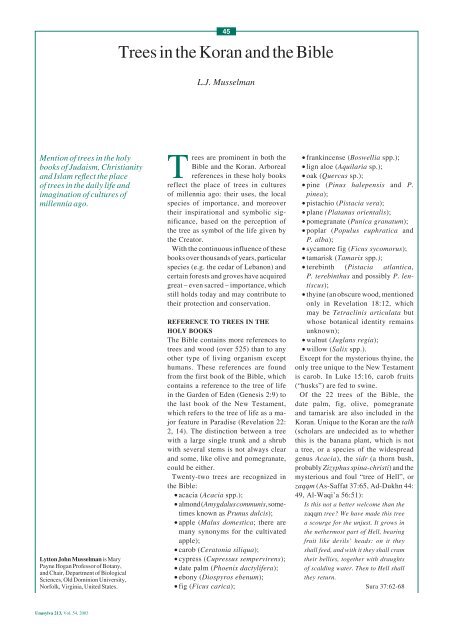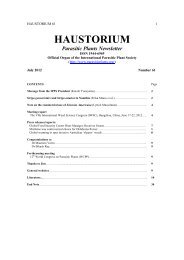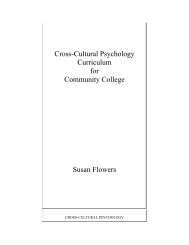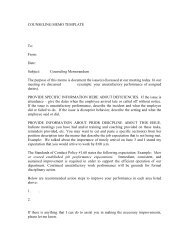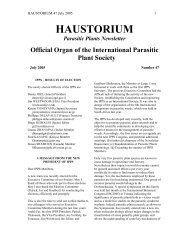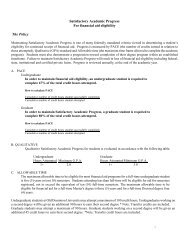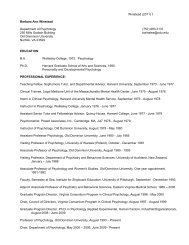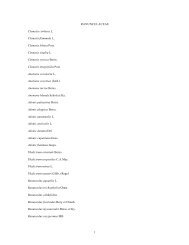Trees in the Koran and the Bible - Old Dominion University
Trees in the Koran and the Bible - Old Dominion University
Trees in the Koran and the Bible - Old Dominion University
You also want an ePaper? Increase the reach of your titles
YUMPU automatically turns print PDFs into web optimized ePapers that Google loves.
Mention of trees <strong>in</strong> <strong>the</strong> holy<br />
books of Judaism, Christianity<br />
<strong>and</strong> Islam refl ect <strong>the</strong> place<br />
of trees <strong>in</strong> <strong>the</strong> daily life <strong>and</strong><br />
imag<strong>in</strong>ation of cultures of<br />
millennia ago.<br />
Lytton John Musselman is Mary<br />
Payne Hogan Professor of Botany,<br />
<strong>and</strong> Chair, Department of Biological<br />
Sciences, <strong>Old</strong> Dom<strong>in</strong>ion <strong>University</strong>,<br />
Norfolk, Virg<strong>in</strong>ia, United States.<br />
Unasylva 213, Vol. 54, 2003<br />
45<br />
<strong>Trees</strong> <strong>in</strong> <strong>the</strong> <strong>Koran</strong> <strong>and</strong> <strong>the</strong> <strong>Bible</strong><br />
L.J. Musselman<br />
T<br />
rees are prom<strong>in</strong>ent <strong>in</strong> both <strong>the</strong><br />
<strong>Bible</strong> <strong>and</strong> <strong>the</strong> <strong>Koran</strong>. Arboreal<br />
references <strong>in</strong> <strong>the</strong>se holy books<br />
reflect <strong>the</strong> place of trees <strong>in</strong> cultures<br />
of millennia ago: <strong>the</strong>ir uses, <strong>the</strong> local<br />
species of importance, <strong>and</strong> moreover<br />
<strong>the</strong>ir <strong>in</strong>spirational <strong>and</strong> symbolic significance,<br />
based on <strong>the</strong> perception of<br />
<strong>the</strong> tree as symbol of <strong>the</strong> life given by<br />
<strong>the</strong> Creator.<br />
With <strong>the</strong> cont<strong>in</strong>uous <strong>in</strong>fluence of <strong>the</strong>se<br />
books over thous<strong>and</strong>s of years, particular<br />
species (e.g. <strong>the</strong> cedar of Lebanon) <strong>and</strong><br />
certa<strong>in</strong> forests <strong>and</strong> groves have acquired<br />
great – even sacred – importance, which<br />
still holds today <strong>and</strong> may contribute to<br />
<strong>the</strong>ir protection <strong>and</strong> conservation.<br />
REFERENCE TO TREES IN THE<br />
HOLY BOOKS<br />
The <strong>Bible</strong> conta<strong>in</strong>s more references to<br />
trees <strong>and</strong> wood (over 525) than to any<br />
o<strong>the</strong>r type of liv<strong>in</strong>g organism except<br />
humans. These references are found<br />
from <strong>the</strong> first book of <strong>the</strong> <strong>Bible</strong>, which<br />
conta<strong>in</strong>s a reference to <strong>the</strong> tree of life<br />
<strong>in</strong> <strong>the</strong> Garden of Eden (Genesis 2:9) to<br />
<strong>the</strong> last book of <strong>the</strong> New Testament,<br />
which refers to <strong>the</strong> tree of life as a major<br />
feature <strong>in</strong> Paradise (Revelation 22:<br />
2, 14). The dist<strong>in</strong>ction between a tree<br />
with a large s<strong>in</strong>gle trunk <strong>and</strong> a shrub<br />
with several stems is not always clear<br />
<strong>and</strong> some, like olive <strong>and</strong> pomegranate,<br />
could be ei<strong>the</strong>r.<br />
Twenty-two trees are recognized <strong>in</strong><br />
<strong>the</strong> <strong>Bible</strong>:<br />
• acacia (Acacia spp.);<br />
• almond (Amygdalus communis, sometimes<br />
known as Prunus dulcis);<br />
• apple (Malus domestica; <strong>the</strong>re are<br />
many synonyms for <strong>the</strong> cultivated<br />
apple);<br />
• carob (Ceratonia siliqua);<br />
• cypress (Cupressus sempervirens);<br />
• date palm (Phoenix dactylifera);<br />
• ebony (Diospyros ebenum);<br />
• fig (Ficus carica);<br />
• frank<strong>in</strong>cense (Boswellia spp.);<br />
• lign aloe (Aquilaria sp.);<br />
• oak (Quercus sp.);<br />
• p<strong>in</strong>e (P<strong>in</strong>us halepensis <strong>and</strong> P.<br />
p<strong>in</strong>ea);<br />
• pistachio (Pistacia vera);<br />
• plane (Platanus orientalis);<br />
• pomegranate (Punica granatum);<br />
• poplar (Populus euphratica <strong>and</strong><br />
P. alba);<br />
• sycamore fig (Ficus sycomorus);<br />
• tamarisk (Tamarix spp.);<br />
• tereb<strong>in</strong>th (Pistacia atlantica,<br />
P. tereb<strong>in</strong>thus <strong>and</strong> possibly P. lentiscus);<br />
• thy<strong>in</strong>e (an obscure wood, mentioned<br />
only <strong>in</strong> Revelation 18:12, which<br />
may be Tetracl<strong>in</strong>is articulata but<br />
whose botanical identity rema<strong>in</strong>s<br />
unknown);<br />
• walnut (Juglans regia);<br />
• willow (Salix spp.).<br />
Except for <strong>the</strong> mysterious thy<strong>in</strong>e, <strong>the</strong><br />
only tree unique to <strong>the</strong> New Testament<br />
is carob. In Luke 15:16, carob fruits<br />
(“husks”) are fed to sw<strong>in</strong>e.<br />
Of <strong>the</strong> 22 trees of <strong>the</strong> <strong>Bible</strong>, <strong>the</strong><br />
date palm, fig, olive, pomegranate<br />
<strong>and</strong> tamarisk are also <strong>in</strong>cluded <strong>in</strong> <strong>the</strong><br />
<strong>Koran</strong>. Unique to <strong>the</strong> <strong>Koran</strong> are <strong>the</strong> talh<br />
(scholars are undecided as to whe<strong>the</strong>r<br />
this is <strong>the</strong> banana plant, which is not<br />
a tree, or a species of <strong>the</strong> widespread<br />
genus Acacia), <strong>the</strong> sidr (a thorn bush,<br />
probably Zizyphus sp<strong>in</strong>a-christi) <strong>and</strong> <strong>the</strong><br />
mysterious <strong>and</strong> foul “tree of Hell”, or<br />
zaqqm (As-Saffat 37:65, Ad-Dukhn 44:<br />
49, Al-Waqi’a 56:51):<br />
Is this not a better welcome than <strong>the</strong><br />
zaqqm tree? We have made this tree<br />
a scourge for <strong>the</strong> unjust. It grows <strong>in</strong><br />
<strong>the</strong> ne<strong>the</strong>rmost part of Hell, bear<strong>in</strong>g<br />
fruit like devils’ heads: on it <strong>the</strong>y<br />
shall feed, <strong>and</strong> with it <strong>the</strong>y shall cram<br />
<strong>the</strong>ir bellies, toge<strong>the</strong>r with draughts<br />
of scald<strong>in</strong>g water. Then to Hell shall<br />
<strong>the</strong>y return.<br />
Sura 37:62-68
Religious texts such as <strong>the</strong> Islamic<br />
Hadiths, <strong>the</strong> Judaic Mishnah <strong>and</strong> <strong>the</strong><br />
writ<strong>in</strong>gs of <strong>the</strong> early Christian church<br />
fa<strong>the</strong>rs also conta<strong>in</strong> much <strong>in</strong>formation<br />
on plant lore <strong>and</strong> legend. Indeed, some<br />
references to plants <strong>in</strong> early Christian<br />
writ<strong>in</strong>gs have become so familiar that<br />
<strong>the</strong>y are now <strong>in</strong>ferred to orig<strong>in</strong>ate <strong>in</strong><br />
<strong>the</strong> sacred texts. For example, Judaeo-<br />
Christian tradition generally holds that <strong>in</strong><br />
<strong>the</strong> Garden of Eden, Eve enticed Adam<br />
with an apple from <strong>the</strong> forbidden tree.<br />
However, <strong>in</strong> <strong>the</strong> <strong>Old</strong> Testament book of<br />
Genesis, <strong>the</strong> tree that is l<strong>in</strong>ked to <strong>the</strong><br />
disobedience of Adam <strong>and</strong> Eve is not<br />
identified as an apple.<br />
WHY ARE TREES VENERATED?<br />
People have always worshipped trees.<br />
Early tree worship by pre-mono<strong>the</strong>istic<br />
religions is recorded <strong>in</strong> numerous<br />
Greek <strong>and</strong> Sumerian classics. The ancient<br />
Greeks regarded trees as <strong>the</strong> first<br />
temples of <strong>the</strong> gods <strong>and</strong> sacred groves<br />
as <strong>the</strong>ir first places of worship, where<br />
<strong>the</strong> powerful forces of nature <strong>in</strong>spired<br />
human image mak<strong>in</strong>g (Baumann, 1993).<br />
Groves of trees, often dark <strong>and</strong> mysteri-<br />
46<br />
46<br />
Whence <strong>the</strong> apple tree?<br />
European tradition portrays Eve<br />
tempt<strong>in</strong>g Adam with an apple<br />
(as <strong>in</strong> this pa<strong>in</strong>t<strong>in</strong>g by Hugo van<br />
der Goes, c. 1467), but <strong>in</strong> <strong>the</strong><br />
<strong>Old</strong> Testament <strong>the</strong> tree of <strong>the</strong><br />
knowledge of good <strong>and</strong> evil is not<br />
identifi ed as such<br />
ous, were thought of as haunts of spirits.<br />
The pagan use of trees <strong>and</strong> groves for<br />
worship is mentioned <strong>in</strong> <strong>the</strong> <strong>Bible</strong>:<br />
… places on <strong>the</strong> high mounta<strong>in</strong>s <strong>and</strong><br />
on <strong>the</strong> hills <strong>and</strong> under every spread<strong>in</strong>g<br />
tree where <strong>the</strong> nations … worship<br />
<strong>the</strong>ir gods.<br />
Deuteronomy 12:2<br />
[K<strong>in</strong>g Ahaz] … offered sacrifices<br />
<strong>and</strong> burned <strong>in</strong>cense … under every<br />
spread<strong>in</strong>g tree.<br />
II Chronicles 28:2<br />
Size, age, beauty <strong>and</strong> utility are features<br />
of trees that elicit admiration from<br />
humans. Many trees are impressive <strong>in</strong><br />
size, among <strong>the</strong> largest liv<strong>in</strong>g th<strong>in</strong>gs.<br />
They are probably especially impos<strong>in</strong>g<br />
<strong>in</strong> <strong>the</strong> Near East, where <strong>the</strong> distribution<br />
of trees is frequently limited. Tower<strong>in</strong>g<br />
over a person, extend<strong>in</strong>g from <strong>the</strong><br />
ground <strong>and</strong> reach<strong>in</strong>g <strong>in</strong>to <strong>the</strong> sky, trees<br />
have been revered as a l<strong>in</strong>k between<br />
heaven <strong>and</strong> earth.<br />
<strong>Trees</strong> are also <strong>the</strong> oldest organisms that<br />
most people ever see. Village trees <strong>in</strong><br />
public places, for example near wells,<br />
transcend generations <strong>and</strong> are often<br />
protected. Frequently gnarled with age,<br />
such ancient trees never<strong>the</strong>less appear<br />
to be “reborn” with each new grow<strong>in</strong>g<br />
season. With a long life span relative to<br />
that of a person, <strong>the</strong>y may be perceived<br />
as eternal.<br />
<strong>Trees</strong> provide shade, food <strong>and</strong> fibre <strong>and</strong><br />
have many o<strong>the</strong>r uses. Both <strong>the</strong> <strong>Koran</strong><br />
<strong>and</strong> <strong>the</strong> <strong>Bible</strong> abound <strong>in</strong> references to<br />
trees as a gift from <strong>the</strong> deity. Like <strong>the</strong><br />
features of size, longevity <strong>and</strong> beauty,<br />
<strong>the</strong> utility of trees adds to <strong>the</strong> perception<br />
that <strong>the</strong>y have div<strong>in</strong>e attributes.<br />
ANCIENT USES OF TREES<br />
Both <strong>the</strong> <strong>Bible</strong> <strong>and</strong> <strong>the</strong> <strong>Koran</strong> refer to<br />
<strong>the</strong> utility of trees for food, animal feed,<br />
oil, woodfuel (<strong>in</strong>clud<strong>in</strong>g charcoal) <strong>and</strong><br />
construction.<br />
<strong>Trees</strong> are mentioned as a source of<br />
food <strong>in</strong> <strong>the</strong> earliest chapters of <strong>the</strong><br />
<strong>Bible</strong> (Genesis 1:29). Because of <strong>the</strong><br />
importance of trees for food, cutt<strong>in</strong>g<br />
fruit-trees dur<strong>in</strong>g <strong>the</strong> siege of an enemy<br />
town was prohibited (Deuteronomy 20:<br />
19-20). The <strong>Koran</strong> refers to <strong>the</strong> use of<br />
olives for food, while <strong>the</strong> <strong>Bible</strong> refers<br />
to <strong>the</strong>ir use only for oil.<br />
In <strong>the</strong> <strong>Koran</strong>, at least two verses (Sura<br />
36:80 <strong>and</strong> 56:72) record fuelwood as a<br />
div<strong>in</strong>e provision.<br />
One of <strong>the</strong> specialized uses of trees<br />
<strong>in</strong> <strong>the</strong> <strong>Bible</strong> was for tensile material, as<br />
noted <strong>in</strong> several chapters of Exodus. The<br />
boards <strong>and</strong> poles as well as <strong>the</strong> furniture<br />
for <strong>the</strong> tabernacle, <strong>in</strong>clud<strong>in</strong>g <strong>the</strong> Ark of<br />
<strong>the</strong> Covenant, were all made from acacia.<br />
Historically, <strong>the</strong> cedar of Lebanon<br />
was one of <strong>the</strong> most important build<strong>in</strong>g<br />
materials <strong>in</strong> <strong>the</strong> Near East (Bikai, 1991).<br />
The first construction use of cedar mentioned<br />
<strong>in</strong> <strong>the</strong> <strong>Bible</strong> was for royal palaces.<br />
The most famous cedar build<strong>in</strong>g, though<br />
not <strong>the</strong> largest, was <strong>the</strong> temple built by<br />
Solomon. In addition, Solomon built a<br />
magnificent home for himself entirely<br />
out of cedar (I K<strong>in</strong>gs 7); it took 13 years<br />
to complete, six more years than for <strong>the</strong><br />
temple. Earlier, Solomon’s fa<strong>the</strong>r had<br />
built a house out of cedar (II Samuel 7:<br />
2). A lesser-known use of cedar was <strong>in</strong><br />
oblations for purification, for example,<br />
<strong>in</strong> ritual cleans<strong>in</strong>g for leprosy (Leviticus<br />
14; Numbers 19:6). Details are not given,<br />
but it seems likely that small pieces of<br />
cedar were used for <strong>the</strong>ir fragrance.<br />
Early <strong>in</strong> <strong>the</strong> <strong>Bible</strong>, trees are mentioned<br />
Unasylva 213, Vol. 54, 2003
Tree formations<br />
around places of<br />
worship <strong>in</strong> <strong>the</strong> Near<br />
East<br />
A. Daoud<br />
<strong>Trees</strong> planted or preserved<br />
around monasteries, shr<strong>in</strong>es,<br />
cemeteries <strong>and</strong> mosques came to<br />
be viewed as part of <strong>the</strong> sanctity of<br />
<strong>the</strong>se places <strong>and</strong> are protected to<br />
<strong>the</strong> present day.<br />
Ali Daoud is Director of Forests, M<strong>in</strong>istry of<br />
Agriculture <strong>and</strong> Agrarian Reform, Damascus,<br />
Syrian Arab Republic.<br />
Unasylva Unasylva 213, 212, 213, Vol. Vol. 55, 54, 2003<br />
2003<br />
47<br />
The Near East is <strong>the</strong> cradle of ancient civilizations<br />
such as <strong>the</strong> Babylonian, Assyrian, Phoenician,<br />
Sumerian, Pharaonic, Aramaic <strong>and</strong> Arabian.<br />
Many religions appeared with <strong>the</strong> development<br />
of ancient civilizations <strong>in</strong> <strong>the</strong> region. The presence<br />
of <strong>the</strong>se civilizations brought about reciprocal<br />
effects between humans <strong>and</strong> nature – <strong>in</strong>clud<strong>in</strong>g<br />
forests <strong>and</strong> trees.<br />
Out of forests <strong>and</strong> trees ancient peoples built<br />
<strong>the</strong>ir boats, temples <strong>and</strong> palaces. For example, <strong>in</strong><br />
ancient Egypt, temples, <strong>the</strong> houses of <strong>the</strong> gods,<br />
were built us<strong>in</strong>g <strong>the</strong> same elements as normal<br />
houses. Their columns were orig<strong>in</strong>ally made of<br />
papyrus, reeds <strong>and</strong> palms; only later was stone<br />
used to imitate <strong>the</strong> natural materials.<br />
Forests <strong>in</strong> <strong>the</strong> Near East retreated under <strong>the</strong><br />
impact of civilization <strong>and</strong> numerous <strong>in</strong>vasions.<br />
They have fur<strong>the</strong>r retreated <strong>in</strong> contemporary times<br />
<strong>in</strong> <strong>the</strong> face of agricultural <strong>and</strong> residential expansion<br />
until <strong>the</strong>y are now conf<strong>in</strong>ed to remote mounta<strong>in</strong>ous<br />
areas. Yet <strong>in</strong> many locations, old <strong>in</strong>dividual trees<br />
or tree formations are observed <strong>in</strong> gardens <strong>and</strong><br />
around monasteries, monks’ cells, holy shr<strong>in</strong>es,<br />
cemeteries <strong>and</strong> sometimes mosques.<br />
How have monasteries, shr<strong>in</strong>es <strong>and</strong> mosques<br />
secured protection for <strong>the</strong>se trees for hundreds<br />
<strong>and</strong> sometimes thous<strong>and</strong>s of years?<br />
Heavenly revelations have on <strong>the</strong> whole called<br />
for <strong>the</strong> cherish<strong>in</strong>g of trees <strong>and</strong> forbidden <strong>in</strong>flict<strong>in</strong>g<br />
harm on <strong>the</strong>m. Monks, priests <strong>and</strong> mystics planted<br />
trees <strong>in</strong> <strong>the</strong> gardens of <strong>the</strong>ir premises <strong>and</strong> protected<br />
relic tree st<strong>and</strong>s around <strong>the</strong>m. With respect for<br />
<strong>the</strong>se holy people <strong>and</strong> religious values, people<br />
cont<strong>in</strong>ued to protect <strong>and</strong> care for <strong>the</strong>se trees,<br />
which became almost sacred. <strong>Trees</strong> came to be<br />
viewed as part of <strong>the</strong> sanctity of <strong>the</strong>se places,<br />
besides be<strong>in</strong>g environmentally, culturally <strong>and</strong><br />
spiritually connected to <strong>the</strong> sa<strong>in</strong>ts that <strong>the</strong> sites<br />
commemorated. In <strong>the</strong> coastal mounta<strong>in</strong>s of <strong>the</strong><br />
Syrian Arab Republic, for <strong>in</strong>stance, forests have<br />
retreated from <strong>the</strong> mounta<strong>in</strong>s or become degraded<br />
through years of graz<strong>in</strong>g <strong>and</strong> cutt<strong>in</strong>g. However,<br />
<strong>the</strong>se mounta<strong>in</strong>s still have old, small forest patches,<br />
surrounded by bare or agricultural l<strong>and</strong>s, which<br />
usually mark a sa<strong>in</strong>t’s burial ground. The trees<br />
have rema<strong>in</strong>ed despite <strong>the</strong> people’s need for wood<br />
for heat<strong>in</strong>g, build<strong>in</strong>g or o<strong>the</strong>r uses. Even <strong>the</strong> dead<br />
trees or parts of <strong>the</strong>m are barely touched, as if <strong>the</strong><br />
souls of <strong>the</strong> sa<strong>in</strong>ts have formed a spiritual fence<br />
around <strong>the</strong>m.<br />
The evergreen oak Quercus callebr<strong>in</strong>os is <strong>the</strong><br />
most common tree around Islamic mausoleums<br />
<strong>in</strong> <strong>the</strong> eastern Mediterranean. It gradually<br />
starts to merge with deciduous oaks such as<br />
Q. <strong>in</strong>fectoria <strong>and</strong> Q. cerris. Brutia p<strong>in</strong>e (P<strong>in</strong>us<br />
brutia) is encountered as <strong>in</strong>dividual trees or<br />
st<strong>and</strong>s around monasteries <strong>in</strong> Greece, <strong>the</strong> isl<strong>and</strong>s<br />
of <strong>the</strong> Aegean Sea, Cyprus, Turkey, <strong>the</strong> Syrian<br />
Arab Republic <strong>and</strong> nor<strong>the</strong>rn Iraq. A number of<br />
o<strong>the</strong>r old trees of <strong>the</strong> Mediterranean bas<strong>in</strong> such as<br />
P<strong>in</strong>us p<strong>in</strong>ea, Cupressus sempervirens, Juniperus<br />
drupacea <strong>and</strong> Juniperus oxycedrus also form part<br />
of <strong>the</strong> tree mosaic around places of worship <strong>and</strong><br />
mausoleums.<br />
The ages of trees around places of religious<br />
<strong>in</strong>terest is largely <strong>in</strong>dexed to <strong>the</strong> ages of <strong>the</strong>se<br />
places. It would be <strong>in</strong>terest<strong>in</strong>g to <strong>in</strong>vestigate <strong>the</strong><br />
exact ages of <strong>the</strong>se native or planted trees.
as a source not only of food, but of beauty<br />
(Genesis 2:8). The beauty of trees is also<br />
a <strong>the</strong>me <strong>in</strong> <strong>the</strong> Song of Solomon. In Deuteronomy<br />
8:8, olive, fig <strong>and</strong> pomegranate<br />
are especially s<strong>in</strong>gled out as a bless<strong>in</strong>g<br />
from God. Likewise, <strong>the</strong> <strong>Koran</strong> describes<br />
fruit-trees as a gift of God.<br />
SYMBOLIC IMAGERY<br />
Beyond mention of <strong>the</strong>ir utility, trees are<br />
important <strong>in</strong> both of <strong>the</strong>se holy books<br />
as symbol <strong>and</strong> metaphor.<br />
In <strong>the</strong> two books, <strong>the</strong> good tree is<br />
equated with a good person <strong>and</strong> <strong>the</strong> bad<br />
tree with a bad person. For example,<br />
from <strong>the</strong> <strong>Koran</strong>:<br />
Do you not see how God compares a<br />
good word to a good tree? Its root is<br />
firm <strong>and</strong> its branches are <strong>in</strong> <strong>the</strong> sky;<br />
it yields its fruit <strong>in</strong> every season by<br />
God’s leave. God speaks <strong>in</strong> parables<br />
to mank<strong>in</strong>d so that <strong>the</strong>y may take heed.<br />
But an evil word is like an evil tree<br />
torn out of <strong>the</strong> earth <strong>and</strong> shorn of all<br />
its roots.<br />
Sura 14:24-25<br />
And from <strong>the</strong> <strong>Bible</strong>:<br />
He is like a tree planted by a stream<br />
of water which yields its fruit <strong>in</strong> season<br />
<strong>and</strong> whose leaf does not wi<strong>the</strong>r.<br />
Whatever he does prospers.<br />
Psalms 1:3<br />
The righteous will flourish like a palm<br />
tree; <strong>the</strong>y will grow like a cedar of<br />
Lebanon.<br />
Psalms 92:12<br />
The <strong>Bible</strong> explicitly likens great men to<br />
trees. For example, Daniel, <strong>in</strong>terpret<strong>in</strong>g<br />
K<strong>in</strong>g Nebuchadnezzar’s dream about a<br />
tree, says, “… You, O K<strong>in</strong>g, are that<br />
tree!”(Daniel 4:22). In Ezekiel 31:3,<br />
<strong>the</strong> K<strong>in</strong>g of Assyria is called a cedar<br />
of Lebanon: “Consider Assyria, once<br />
a cedar <strong>in</strong> Lebanon, with beautiful<br />
branches overshadow<strong>in</strong>g <strong>the</strong> forest;<br />
it towered on high, its top above <strong>the</strong><br />
thick foliage.”<br />
In both <strong>the</strong> <strong>Bible</strong> <strong>and</strong> <strong>the</strong> <strong>Koran</strong>, trees<br />
48<br />
48<br />
symbolize eternity <strong>and</strong> are associated<br />
with <strong>the</strong> heavenly state. An example<br />
is <strong>the</strong> tree of life <strong>in</strong> <strong>the</strong> <strong>Bible</strong>, which<br />
is mentioned <strong>in</strong> <strong>the</strong> Garden of Eden as<br />
well as <strong>in</strong> <strong>the</strong> eternal afterlife. And from<br />
<strong>the</strong> <strong>Koran</strong>:<br />
Those on <strong>the</strong> right h<strong>and</strong> – happy shall<br />
be those on <strong>the</strong> right h<strong>and</strong>! They shall<br />
recl<strong>in</strong>e on couches raised on high <strong>in</strong><br />
<strong>the</strong> shade of thornless sidrs <strong>and</strong> clusters<br />
of talh; amidst gush<strong>in</strong>g waters<br />
<strong>and</strong> abundant fruits, unforbidden,<br />
never end<strong>in</strong>g.<br />
Sura 56:27-33<br />
In a sense, <strong>the</strong> message of <strong>the</strong> <strong>Bible</strong><br />
can be summed up by <strong>the</strong> symbolism<br />
of four trees. The first was <strong>the</strong> tree of<br />
life <strong>in</strong> <strong>the</strong> paradise of <strong>the</strong> Garden of<br />
Eden (Genesis 3:22-24). This became<br />
<strong>the</strong> tree of <strong>the</strong> knowledge of good <strong>and</strong><br />
evil (<strong>the</strong> second tree) of which Adam<br />
<strong>and</strong> Eve ate <strong>the</strong> fruit, caus<strong>in</strong>g <strong>the</strong> fall<br />
(Genesis 3:4-6, 17-18). Third, Jesus’s<br />
cross is referred to as a “tree” <strong>and</strong> is<br />
l<strong>in</strong>ked to Deuteronomy 21:22-23: “If<br />
a man guilty of a capital offence is<br />
put to death <strong>and</strong> his body is hung on<br />
a tree, you must not leave his body on<br />
<strong>the</strong> tree overnight. Be sure to bury him<br />
that same day, because anyone who is<br />
hung on a tree is under God’s curse”.<br />
In <strong>the</strong> Christian doctr<strong>in</strong>e of salvation,<br />
Jesus tak<strong>in</strong>g <strong>the</strong> curse removes <strong>the</strong> curse<br />
of <strong>the</strong> tree of good <strong>and</strong> evil <strong>and</strong> leads<br />
to <strong>the</strong> last tree: <strong>the</strong> tree of life <strong>in</strong> <strong>the</strong><br />
paradise of God with “… leaves of <strong>the</strong><br />
tree … for <strong>the</strong> heal<strong>in</strong>g of <strong>the</strong> nations.<br />
No longer will <strong>the</strong>re be any curse”<br />
(Revelation 22:1-3).<br />
CULTURAL REFLECTIONS<br />
Both <strong>the</strong> <strong>Koran</strong> <strong>and</strong> <strong>the</strong> <strong>Bible</strong> were culturally<br />
relevant to <strong>the</strong>ir orig<strong>in</strong>al readers.<br />
The plants familiar to <strong>the</strong> cultures that<br />
gave rise to <strong>the</strong>se books <strong>in</strong>fluenced <strong>the</strong>ir<br />
tree imagery. Over <strong>the</strong> centuries, <strong>the</strong>se<br />
texts have <strong>in</strong>fluenced <strong>the</strong> people who<br />
have adopted <strong>the</strong>m as sacred.<br />
A good example of cultural <strong>in</strong>fluence<br />
is <strong>the</strong> <strong>in</strong>clusion of Greek plant lore <strong>in</strong><br />
<strong>the</strong> New Testament, which was heavily<br />
<strong>in</strong>fluenced by Greek culture <strong>and</strong><br />
written <strong>in</strong> Greek; some of <strong>the</strong>se plants<br />
were not common <strong>in</strong> <strong>the</strong> l<strong>and</strong>s of <strong>the</strong> <strong>Old</strong><br />
Testament. For <strong>in</strong>stance, <strong>in</strong> I Peter 5:4,<br />
a w<strong>in</strong>ner of a sports event is crowned<br />
with leaves of <strong>the</strong> shrub Laurus nobilis,<br />
“… <strong>the</strong> crown of glory that will never<br />
fade away”. Laurus nobilis is one of <strong>the</strong><br />
few examples of a plant mentioned <strong>in</strong><br />
<strong>the</strong> New Testament but not <strong>in</strong> <strong>the</strong> <strong>Old</strong><br />
Testament.<br />
Biblical or <strong>Koran</strong>ic names are frequently<br />
used outside <strong>the</strong> Near East for<br />
<strong>in</strong>digenous plants that never grew <strong>in</strong> <strong>the</strong><br />
l<strong>and</strong>s where <strong>the</strong>se two books orig<strong>in</strong>ated.<br />
The flora of eastern North America, for<br />
example, has many “cedars”, which<br />
are not related to <strong>the</strong> cedar of Lebanon<br />
(Cedrus libani) of <strong>the</strong> <strong>Bible</strong>. Perhaps<br />
because <strong>the</strong> cedar of Lebanon was<br />
such a well-recognized symbol from<br />
<strong>the</strong> <strong>Bible</strong>, <strong>the</strong> early Christian settlers<br />
<strong>in</strong> North America gave this name to<br />
many different trees (<strong>and</strong> even to many<br />
herbaceous plants), whe<strong>the</strong>r or not <strong>the</strong>y<br />
were true cedars or even members of <strong>the</strong><br />
same botanical family. For example, <strong>the</strong><br />
widespread red cedar of eastern North<br />
America (Juniperus virg<strong>in</strong>iana), like<br />
Cedrus libani, is an evergreen <strong>and</strong> has<br />
a pleasant, endur<strong>in</strong>g fragrance, but its<br />
cone is fleshy <strong>and</strong> berry-like, unlike <strong>the</strong><br />
large sp<strong>in</strong>dle-shaped cone of <strong>the</strong> cedar<br />
of Lebanon.<br />
Similarly, <strong>in</strong> eastern Sudan, <strong>the</strong> Beja<br />
people call <strong>the</strong> large, arborescent cactus<br />
Euphorbia abyss<strong>in</strong>ica “zaqqm” after <strong>the</strong><br />
tree of Hell mentioned <strong>in</strong> <strong>the</strong> <strong>Koran</strong>. It<br />
is unlikely that <strong>the</strong> conception of <strong>the</strong><br />
zaqqm <strong>in</strong> <strong>the</strong> <strong>Koran</strong> was based on this<br />
succulent, s<strong>in</strong>ce <strong>the</strong> zaqqm fruit was<br />
described as resembl<strong>in</strong>g a devil’s head,<br />
for <strong>in</strong>stance. It is perhaps ow<strong>in</strong>g to its<br />
very bitter sap that Euphorbia abyss<strong>in</strong>ica<br />
has been likened to <strong>the</strong> zaqqm.<br />
Unasylva 213, Vol. 54, 2003
L. MUSSELMAN<br />
REFERENCES TO LOCAL TREES:<br />
TAMARISK AND POMEGRANATE<br />
Underst<strong>and</strong><strong>in</strong>g <strong>the</strong> flora of <strong>the</strong> regions<br />
where <strong>the</strong> sacred text orig<strong>in</strong>ated helps to<br />
underst<strong>and</strong> <strong>the</strong> text itself. Both <strong>the</strong> <strong>Koran</strong><br />
<strong>and</strong> <strong>the</strong> <strong>Bible</strong> draw upon local trees.<br />
Tamarisks, for <strong>in</strong>stance, a species of <strong>the</strong><br />
genus Tamarix, are very common trees<br />
<strong>and</strong> shrubs <strong>in</strong> parts of <strong>the</strong> Near East <strong>and</strong><br />
have now become serious weeds <strong>in</strong> o<strong>the</strong>r<br />
parts of <strong>the</strong> world. They often grow <strong>in</strong><br />
some of <strong>the</strong> most difficult environments<br />
for plants. For example, <strong>the</strong>y tolerate<br />
soils with high salt concentration <strong>and</strong><br />
are <strong>the</strong>refore <strong>the</strong> only trees found on<br />
<strong>the</strong> shores of <strong>the</strong> Dead Sea.<br />
In <strong>the</strong> <strong>Koran</strong>, tamarisks are used to<br />
describe <strong>the</strong> notion of a degraded environment:<br />
“So We let loose upon <strong>the</strong>m<br />
<strong>the</strong> waters of <strong>the</strong> dam <strong>and</strong> replaced <strong>the</strong>ir<br />
A Pistacia atlantica tree near <strong>the</strong><br />
village of Kufr Yusef <strong>in</strong> Galilee,<br />
Israel honours a local girl who<br />
is considered a k<strong>in</strong>d of sa<strong>in</strong>t by<br />
Muslims<br />
Unasylva 213, Vol. 54, 2003<br />
49<br />
gardens by two o<strong>the</strong>rs bear<strong>in</strong>g bitter fruit,<br />
tamarisks, <strong>and</strong> a few nettles [sometimes<br />
translated as stunted lote trees]” (Sura<br />
34:16). In <strong>the</strong> <strong>Bible</strong>, <strong>the</strong> prophet Abraham<br />
planted a tamarisk tree to honour<br />
God (Genesis 20:33).<br />
The pomegranate is widely used <strong>in</strong> <strong>the</strong><br />
Near East. In <strong>the</strong> <strong>Koran</strong>, pomegranates,<br />
Punica granatum, are mentioned as one<br />
of <strong>the</strong> gifts of Allah:<br />
“It is He who sends down water from<br />
<strong>the</strong> sky with which We br<strong>in</strong>g forth <strong>the</strong><br />
buds of every plant. From <strong>the</strong>se We<br />
br<strong>in</strong>g forth green foliage <strong>and</strong> closegrow<strong>in</strong>g<br />
gra<strong>in</strong>, palm-trees laden with<br />
clusters of dates, v<strong>in</strong>eyards <strong>and</strong> olive<br />
groves, <strong>and</strong> pomegranates alike <strong>and</strong><br />
different. Behold <strong>the</strong>ir fruits when <strong>the</strong>y<br />
ripen. Surely <strong>in</strong> <strong>the</strong>se <strong>the</strong>re are signs<br />
for true believers.”<br />
Al-An’_ am 6:99<br />
Similarly, <strong>in</strong> <strong>the</strong> <strong>Bible</strong> pomegranates<br />
come from God (Deuteronomy 8:8).<br />
They are also referred to as objects of<br />
beauty. Pomegranates figure prom<strong>in</strong>ently<br />
<strong>in</strong> three places <strong>in</strong> <strong>the</strong> Scriptures: on<br />
An olive tree <strong>in</strong><br />
<strong>the</strong> Syrian Arabic<br />
Republic associated<br />
with <strong>the</strong> tomb of a<br />
sa<strong>in</strong>t, adorned with<br />
strips<br />
of cloth<br />
<strong>the</strong> garment of <strong>the</strong> high priest (Exodus<br />
28:33), as a garl<strong>and</strong> on <strong>the</strong> pillars <strong>in</strong> <strong>the</strong><br />
temple, <strong>and</strong> <strong>in</strong> <strong>the</strong> Song of Solomon.<br />
Solomon’s temple had two hundred<br />
pomegranates engraved on <strong>the</strong> capitals<br />
of <strong>the</strong> two pillars that were at <strong>the</strong> front of<br />
<strong>the</strong> temple (I K<strong>in</strong>gs 7:42; II Chronicles<br />
4:13). In <strong>the</strong> Song of Solomon 4:3 <strong>and</strong><br />
6:7, <strong>the</strong> red <strong>in</strong>terior of <strong>the</strong> fruit is likened<br />
to <strong>the</strong> temples of <strong>the</strong> Beloved.<br />
PRESENT-DAY VENERATION OF<br />
TREES AND GROVES – A CATALYST<br />
FOR CONSERVATION?<br />
<strong>Trees</strong> are still venerated today <strong>in</strong> many<br />
countries, <strong>in</strong>clud<strong>in</strong>g Iraq, Israel, Lebanon<br />
<strong>and</strong> <strong>the</strong> Syrian Arab Republic. Among<br />
Druze <strong>and</strong> Muslim Arabs, certa<strong>in</strong> <strong>in</strong>dividual<br />
trees are considered holy. These<br />
trees are often near <strong>the</strong> tombs of holy men<br />
or women where visitors come to make<br />
requests. They pledge to do good if <strong>the</strong><br />
requests are fulfi lled, <strong>and</strong> tie cloth, cloth<br />
strips, or rags on to <strong>the</strong> trees as a solemn<br />
<strong>in</strong>dication of <strong>the</strong>ir promise to implement<br />
<strong>the</strong>se vows (Dafni, 2003).<br />
L. MUSSELMAN
G. ALLARD<br />
Sav<strong>in</strong>g <strong>the</strong> cedar of<br />
Lebanon, Cedrus<br />
libani – a cultural<br />
emblem<br />
The cultural signifi cance that<br />
Cedrus libani has held s<strong>in</strong>ce<br />
ancient times helps to expla<strong>in</strong> why<br />
<strong>the</strong> Lebanese Government has<br />
made it a priority <strong>in</strong> recent years<br />
to defend <strong>the</strong> health of <strong>the</strong> cedar<br />
forests.<br />
50<br />
References to <strong>the</strong> cedars of Lebanon go as far back as <strong>the</strong> beg<strong>in</strong>n<strong>in</strong>g of written script (Meiggs, 1982).<br />
The epic of Gilgamesh, which refers to a visit of Gilgamesh <strong>and</strong> Enkidu to <strong>the</strong> Lebanon Mounta<strong>in</strong> to<br />
cut <strong>the</strong> trees, can be traced back to <strong>the</strong> third millennium BC:<br />
They beheld <strong>the</strong> cedar mounta<strong>in</strong>, abode of <strong>the</strong> god,<br />
Throne-seat of Irn<strong>in</strong>i.<br />
From <strong>the</strong> face of <strong>the</strong> mounta<strong>in</strong><br />
The cedars raise aloft <strong>the</strong>ir luxuriance.<br />
Good is <strong>the</strong>ir shade, full of delight.<br />
Epic of Gilgamesh<br />
Fragments of this epic text have been recovered <strong>in</strong> Sumerian, Akkadian, Hittite, Hurrian <strong>and</strong> o<strong>the</strong>r<br />
languages – <strong>in</strong>dicat<strong>in</strong>g that <strong>the</strong>se cedars caught <strong>the</strong> imag<strong>in</strong>ation of people more than 500 km distant.<br />
The same feel<strong>in</strong>g for <strong>the</strong> magnificence of <strong>the</strong> cedars permeates <strong>the</strong> <strong>Old</strong> Testament:<br />
Look at Assyria: it was a cedar <strong>in</strong> Lebanon,<br />
whose fair branches overshadowed <strong>the</strong> forest,<br />
tower<strong>in</strong>g high with its crown f<strong>in</strong>d<strong>in</strong>g a way through <strong>the</strong> foliage.<br />
Spr<strong>in</strong>gs nourished it, underground waters gave it height,<br />
Their streams washed <strong>the</strong> soil all around it<br />
And sent forth <strong>the</strong>ir rills to every tree <strong>in</strong> <strong>the</strong> country.<br />
So it grew taller than every o<strong>the</strong>r tree.<br />
Its boughs were many, its branches spread far;<br />
for water was abundant <strong>in</strong> <strong>the</strong> channels.<br />
In its boughs all <strong>the</strong> birds of <strong>the</strong> air had <strong>the</strong>ir nests,<br />
under its branches all wild creatures bore <strong>the</strong>ir young,<br />
<strong>and</strong> <strong>in</strong> its shadow all great nations made <strong>the</strong>ir home.<br />
A splendid great tree it was, with its long spread<strong>in</strong>g boughs,<br />
for its roots were beside abundant waters.<br />
Ezekiel<br />
But <strong>the</strong> writers of <strong>the</strong> <strong>Old</strong> Testament knew that <strong>the</strong> cedar forest was not merely admired for its beauty;<br />
it provided <strong>the</strong> most sought-after wood <strong>in</strong> <strong>the</strong> Near East. The k<strong>in</strong>gs of Egypt, Mesopotamia, Phoenicia,<br />
Assyria, Babylon, Persia <strong>and</strong> Greece, until <strong>the</strong> region was ruled by Rome, proudly reported provid<strong>in</strong>g<br />
cedar timber for build<strong>in</strong>g temples <strong>and</strong> palaces, obta<strong>in</strong>ed ei<strong>the</strong>r through commercial transactions or<br />
through military expeditions. In <strong>the</strong> tenth century BC, <strong>the</strong> Phoenicians built Solomon a great palace<br />
from cedar wood. Cedar wood was also used <strong>in</strong> build<strong>in</strong>g Aeolon Temple <strong>in</strong> Greece. The ancient<br />
Egyptians not only used cedar wood extensively, but also used a preservative from cedar res<strong>in</strong>, called<br />
“life of <strong>the</strong> dead”, <strong>in</strong> <strong>the</strong>ir embalm<strong>in</strong>g process. Jesus Christ was crucified on a cross allegedly from<br />
Unasylva 213, 212, 213, Vol. 55, 54, 2003
Unasylva 213, 212, 213, Vol. 55, 54, 2003<br />
The Tannour<strong>in</strong>e Forest,<br />
Lebanon, where as much as<br />
80 percent of <strong>the</strong> cedars were<br />
<strong>in</strong>fested by a new <strong>in</strong>sect pest<br />
51<br />
cedar wood. In 118 AD <strong>the</strong> Roman Emperor Hadrian established rules to protect <strong>the</strong> cedars of Lebanon<br />
to prevent deforestation.<br />
Through this long history, a strong cultural l<strong>in</strong>k evolved between this tree <strong>and</strong> <strong>the</strong> people liv<strong>in</strong>g <strong>in</strong><br />
<strong>and</strong> nearby <strong>the</strong> cedar forests. Because of its majesty <strong>and</strong> long life span, <strong>the</strong> cedar became a symbol of<br />
eternity. Tales <strong>and</strong> legends referr<strong>in</strong>g to <strong>the</strong> cedar are numerous <strong>in</strong> Lebanon <strong>and</strong> constitute one of <strong>the</strong><br />
cultural l<strong>in</strong>ks shared by <strong>the</strong> many ethnic, l<strong>in</strong>guistic <strong>and</strong> religious groups liv<strong>in</strong>g <strong>the</strong>re. When <strong>the</strong> country<br />
obta<strong>in</strong>ed <strong>in</strong>dependence, it adopted <strong>the</strong> cedar as its national emblem <strong>and</strong> put this emblem on its flag.<br />
By <strong>the</strong> mid-n<strong>in</strong>eteenth century, however, <strong>the</strong> resource was depleted <strong>and</strong> much concern was expressed<br />
about <strong>the</strong> loss of this important species. S<strong>in</strong>ce <strong>the</strong>n, many attempts have been made by successive<br />
governments, local communities <strong>and</strong> <strong>the</strong> <strong>in</strong>ternational community to protect <strong>and</strong> restore <strong>the</strong> cedar<br />
forests of Lebanon.<br />
The cultural significance of Cedrus libani helps to expla<strong>in</strong> why <strong>the</strong> Lebanese Government, <strong>in</strong> recent<br />
years, made it a priority to defend <strong>the</strong> trees from a serious, previously unrecorded pest, Cephalcia<br />
tannour<strong>in</strong>ensis. This wood wasp threatened to wipe out most of Lebanon’s cedar forests <strong>and</strong> spread<br />
to neighbour<strong>in</strong>g countries. The situation was particularly critical <strong>in</strong> Tannour<strong>in</strong>e-Hadath El-Jebbeh<br />
Forest <strong>in</strong> nor<strong>the</strong>rn Lebanon, one of <strong>the</strong> largest remnants of cedar forest <strong>in</strong> <strong>the</strong> country, with 50 000<br />
trees spread over 600 ha. As much as 80 percent of <strong>the</strong> forest’s cedars were <strong>in</strong>fested. The <strong>in</strong>sect had<br />
also spread to <strong>the</strong> “Forest of <strong>the</strong> Cedars of <strong>the</strong> Gods” <strong>in</strong> Bcharreh, which is on <strong>the</strong> World Heritage<br />
List of <strong>the</strong> United Nations Educational, Scientific <strong>and</strong> Cultural Organization (UNESCO). Forests <strong>in</strong><br />
<strong>the</strong> neighbour<strong>in</strong>g Syrian Arab Republic <strong>and</strong> Turkey were also threatened.<br />
To combat <strong>the</strong> threat, Lebanon brought toge<strong>the</strong>r a team compris<strong>in</strong>g scientists from <strong>the</strong> American<br />
<strong>University</strong> of Beirut, <strong>the</strong> Lebanese M<strong>in</strong>istry of Agriculture <strong>and</strong> French experts. FAO provided funds <strong>and</strong><br />
expertise through its Technical Cooperation Programme. After efforts last<strong>in</strong>g nearly five years, <strong>the</strong> pest<br />
is now reduced to an economic level, but cont<strong>in</strong>ual monitor<strong>in</strong>g of <strong>the</strong> situation is still necessary.<br />
Immediate control methods <strong>in</strong>volved <strong>the</strong> aerial application of biological (non-chemical) pesticides<br />
– <strong>in</strong>sect growth regulators – coupled with studies of <strong>the</strong> pest’s life cycle to determ<strong>in</strong>e <strong>the</strong> correct<br />
treatment w<strong>in</strong>dow. As a portion of <strong>the</strong> life cycle is subterranean, spray<strong>in</strong>g is more effective <strong>in</strong> <strong>the</strong> first<br />
<strong>and</strong> last phases of <strong>the</strong> cycle, when <strong>the</strong> <strong>in</strong>sect lives above ground.<br />
Work is cont<strong>in</strong>u<strong>in</strong>g to identify <strong>the</strong> best tools to prevent new outbreaks <strong>and</strong> control future <strong>in</strong>festations<br />
should <strong>the</strong>y occur. Medium- <strong>and</strong> long-term control strategies <strong>in</strong>clude trapp<strong>in</strong>g, studies on <strong>the</strong> potential<br />
of pheromones for population monitor<strong>in</strong>g <strong>and</strong> biological control measures as part of an ongo<strong>in</strong>g pest<br />
management strategy.<br />
Bibliography<br />
Meiggs, R. 1982. <strong>Trees</strong> <strong>and</strong> timber <strong>in</strong> <strong>the</strong> ancient Mediterranean world. Oxford, UK, Clarendon<br />
Press.<br />
G. ALLARD
L. MUSSELMAN<br />
Less than 3 percent rema<strong>in</strong>s of <strong>the</strong><br />
orig<strong>in</strong>al cedar of Lebanon forest which<br />
once covered much of <strong>the</strong> western slope<br />
of Mount Lebanon. Almost all of this<br />
is protected. One of <strong>the</strong> reserves, called<br />
“The Cedars of <strong>the</strong> Lord” (Arz el-Rab),<br />
a remnant of a few hundred hectares on<br />
Mount Lebanon, has been considered sacred<br />
by <strong>the</strong> Maronite Christians who have<br />
lived <strong>in</strong> <strong>the</strong> region for a millennium.<br />
CONCLUSION<br />
<strong>Trees</strong> have a high frequency <strong>in</strong> <strong>the</strong> <strong>Bible</strong><br />
<strong>and</strong> are so prom<strong>in</strong>ent that <strong>the</strong> ma<strong>in</strong><br />
biblical messages can be summed up by<br />
four trees. In <strong>the</strong> <strong>Koran</strong>, trees are most<br />
frequently cited as gifts of a beneficent<br />
Creator, with <strong>the</strong> notable exception of <strong>the</strong><br />
tree of Hell, zaqqm. In both scriptures,<br />
fruits from trees are highly valued.<br />
The study of trees of <strong>the</strong> holy scriptures<br />
of Islam <strong>and</strong> Judaism <strong>and</strong> Christianity,<br />
<strong>and</strong> <strong>the</strong> observation that trees are<br />
presented as a resource from God,<br />
leads to <strong>the</strong> question of how those who<br />
revere <strong>the</strong> holy scriptures are h<strong>and</strong>l<strong>in</strong>g<br />
52<br />
52<br />
A sculpture by <strong>the</strong><br />
artist Rudy Rahme<br />
depict<strong>in</strong>g a crucifi ed<br />
Christ, located <strong>in</strong> <strong>the</strong><br />
grove of cedars above<br />
<strong>the</strong> Maronite Christian<br />
town of Bsherri on<br />
Mount Lebanon <strong>in</strong><br />
Lebanon<br />
trees. Sayeed Hosse<strong>in</strong> Nasr (1996), <strong>in</strong> a<br />
profound volume on <strong>the</strong> relationship between<br />
religion <strong>and</strong> <strong>the</strong> ecological crisis,<br />
argues that what is needed <strong>in</strong> a modern<br />
world where humans are <strong>in</strong>creas<strong>in</strong>gly<br />
alienated from nature is <strong>the</strong> recovery of<br />
<strong>the</strong> truth to which <strong>the</strong> important endur<strong>in</strong>g<br />
religions all attest, namely, that nature<br />
is sacred.<br />
Bibliography<br />
Baumann, H. 1993. The Greek plant world<br />
<strong>in</strong> myth, art <strong>and</strong> literature. Translated <strong>and</strong><br />
augmented by W. T. Stearn & E. R. Stearn.<br />
Timber Press, Portl<strong>and</strong>, Oregon, USA.<br />
Bikai, P. M. 1991. The cedar of Lebanon:<br />
archaeological <strong>and</strong> dendrochronological<br />
perspectives. Berkeley, California,<br />
<strong>University</strong> of California. (PhD<br />
dissertation)<br />
Dafni, A. 2003. Why are rags tied to <strong>the</strong> sacred<br />
trees of <strong>the</strong> holy l<strong>and</strong>? Economic Botany,<br />
56(4): 315-327.<br />
Dawood, N.J., transl. 1997. The <strong>Koran</strong><br />
with parallel Arabic text. London, UK,<br />
Pengu<strong>in</strong><br />
Hodder <strong>and</strong> Stoughton Publishers. 1986.<br />
The <strong>Bible</strong> – new <strong>in</strong>ternational version.<br />
London, UK.<br />
Nasr, S.H. 1996. Religion <strong>and</strong> <strong>the</strong> order of<br />
nature. New York, USA, Oxford <strong>University</strong><br />
Press.<br />
Unasylva 213, Vol. 54, 2003


